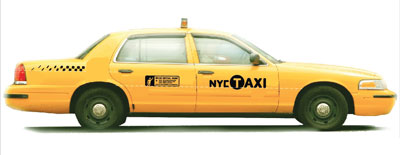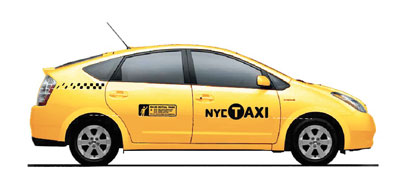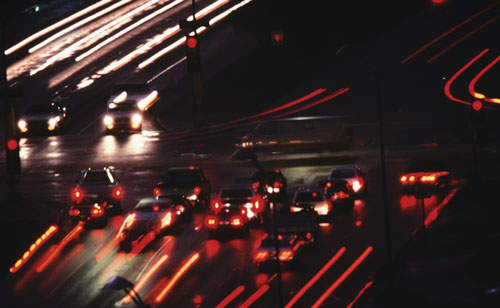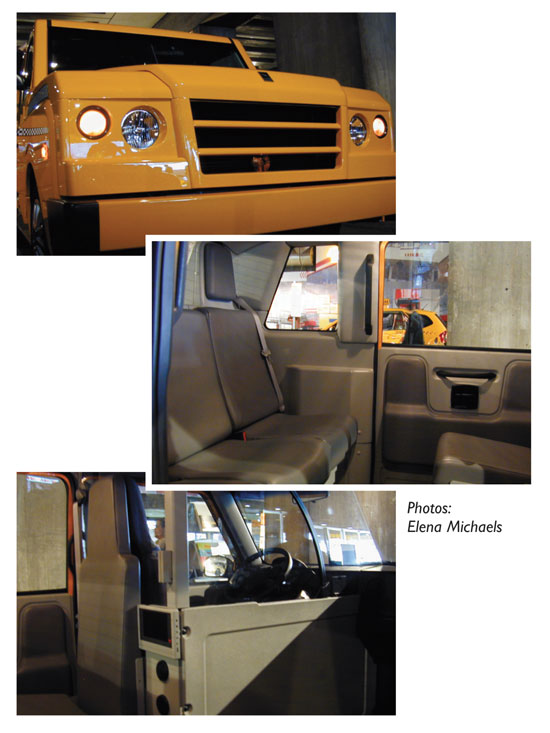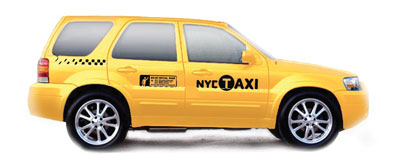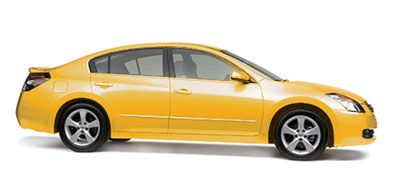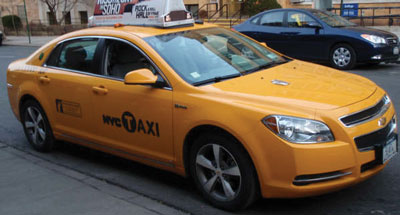


![]()
TAXICAB, LIMOUSINE & PARATRANSIT ASSOCIATION
THE COST OF MAINTAINING A TAXI VEHICLE IN THE U.S. & THE ALTERNATIVE FUEL VEHICLE MYTH
The Taxicab, Limousine & Paratransit Association (TLPA), formed in 1917, is the national organization that represents the owners and managers of taxicab, limousine, sedan, airport shuttle, paratransit, and non-emergency medical fleets. TLPA has approximately 1,000 member companies that operate over 100,000 passenger vehicles.TLPA member companies transport over 2 million passengers each day — more than 900 million passengers annually.
The taxicab, limousine, and paratransit industry is an essential part of public transportation that is vital to this country’s commerce and mobility to the relief of traffic congestion, and to improving the environment.
The private taxicab, limousine, and paratransit industry:
transports 2 billion passengers annually compared with the 10 billion passengers transported by public transit;
- provides half of all the specialized paratransit services furnished to persons with disabilities;
- serves as a feeder service to major transit stations and airports; and
- provides about half of its service to transportation disadvantaged people.
It is our industry’s service flexibility that makes us the public’s choice to provide the first and last segments of a trip, and which enable the passenger to not use his/her private automobile.
Analysis of Alternative Fuels & Vehicles for Taxicab FleetsPrepared by the Taxicab, Limousine & Paratransit Association
Taxicab fleet executives are questioning whether it makes operational and economic sense to convert to alternative fuel vehicles. To investigate and respond to this question a TLPA Vehicle Task Force of 15 industry leaders was appointed to gather data and make a recommendation on alternative fuel taxicabs. In preparation for the Task Force’s internal debate on this important matter articles were collected, fleet operators were interviewed and the promotional materials from alternative fuel vehicle advocates evaluated. The Task Force also reviewed the two court cases in New York City where a federal judge overturned the city’s mandate and subsequent financial disincentive scheme to try to force that taxicabs be alternative fuel vehicles.
From the standpoint of fleet executives the jury is out on the issue of whether or not it makes sense for the taxicab industry to be a leader in the conversion from standard gasoline powered sedans to alternative fuel vehicles.The fact that the majority of the taxicab industry’s economics is based on the purchase of used, large sedans (often two year old police vehicles) works against the industry purchasing new and more costly alternative fuel vehicles.Alternative fuel advocates, on the other hand, believe that reduction in fuel consumption and/or emissions outweighs:
- operational efficiency,
- cost of service, and
- passenger safety and comfort.
The general public has not yet weighed in on whether they are willing to pay to sit in a smaller, more environmentally friendly vehicle.There are successes and failures when it comes to the introduction of alternative fuel vehicles in the taxicab industry.The bottom line, however, is that the TLPA Vehicle Task Force believes that technology is evolving to make widespread use of alternative fuels no longer the dream of the future but a reality that already works for some today and may soon be ready to work for all in the taxicab industry.
The announcement of new vehicle emission and miles per gallon standards made by President Obama on May 19, 2009 will further speed automobile manufacturers’ development of commercial fleet worthy alternative fuel vehicles.The proposed new policy for the first time merges fuel efficiency standards for vehicles with limits on tailpipe pollutants. The new Corporate Average Fuel Economy standard will begin in model year 2012.Automakers will be required to have a fleet average of 35.5 miles a gallon and to reduce tail pipe emission by 30 percent by the year 2016.
In conducting its analysis of alternative fuel vehicles available to meet commercial passenger fleet operator needs the TLPA Vehicle Task Force has made the following conclusions:
1. As of July 2009, an alternative fuel vehicle adequate for taxicab service that meets consumer needs i.e.,
- adequate space for multiple passengers and their luggage;
- fleet operations durability and safety;
- a convenient fuel distribution system that allows unfettered passenger travel and cost effectiveness
is not widely available and we are not certain when such a vehicle and fuel will be generally available.
2. The pace of technological advancements in alternative fuel vehicles is accelerating and it is very likely that within the next few years there will be an affordable and nationally available alternative fuel vehicle that does meet the taxicab industry’s operational needs, our passengers’ safety and comfort needs, provides for significant reductions in emissions, and is far more fuel efficient than today’s typical taxicab.
3. Financial and operational incentives and the transition of police departments to alternative fuel vehicles will speed the taxicab industry’s transition to alternative fuel vehicles. Since a major portion of the taxicab industry purchases used police vehicles, once police departments find a suitable alternative fuel vehicle, then soon thereafter the taxicab industry is likely to have its alternative fuel vehicle of choice. On the other hand, imposition of legally challengeable local mandates serve to create delays and resentments, slowing the real progress toward a workable solution that serves the needs of consumers, fleet operators and politicians.
4. The new national vehicle standards announced by President Obama should lead automobile manufacturers to develop alternative fuel vehicles designed for commercial passenger fleets. No such original equipment manufactured alternative fuel vehicle exists today. Soon, the taxicab industry should have a choice of alternative fuel sedans that are designed for and built to stand up to intense commercial passenger fleet use.
5. No alternative fuel to gasoline currently has a reliable network (statewide or national) of fueling stations that meet the diverse and unscheduled passenger transportation needs of the taxicab industry. A reliable fueling network and better refueling techniques (speed, safety, and ease) are needed. As for the promise of hybrid vehicles the shortage of production capability needs to be resolved to make the batteries available in greater numbers which should lead to greater availability of a variety of hybrid sedans at a lower cost.
Executive SummaryCars, buses, trucks, planes and other mobile sources account for almost a third (27.9%) of the total air pollution in the United States according to the Environmental Protection Agency (EPA)which established vehicle emission standards for cars and trucks in the early 1970s. Since that time, Congress has made vehicle emissions standards increasingly more stringent to address national air quality concerns. Currently, it is estimated that personal vehicles (sedans and light trucks) account for 17% of total air pollution.
State and local government entities are also working to enhance air quality. California is known for establishing more stringent automobile emission standards than the federal standards. Local governments and public entities are also promoting improved air quality through a variety of actions including funding alternative fuel transit buses, making alternative fuel vehicles a substantial advantage or outright requirement when competitively bidding service contracts such as for garbage collection or the priority taxicab concession at the airport. Most recently we have heard of a few police departments that are beginning to investigate the use of alternative fuel vehicles.
Since 2007, New York City, San Francisco, Boston and Seattle have issued local mandates requiring all taxicab fleets to achieve certain city driving mileage per gallon requirements in the near future. The requirements in New York City and Boston were withdrawn by the cities after federal judges issued injunctions barring the cities from enforcing the rules.
The principal reason for the judicial finding was that the plaintiffs were likely to prevail on their argument that when Congress enacted corporate average fuel economy (“CAFE”) standards in the Energy Policy and Conservation Act of 1975 (EPCA”), it had pre-empted state or municipal regulations “related to fuel economy standards or average fuel economy standards for automobiles covered by an average fuel economy standard” under the EPCA. It appears the other city mandates which are based on fuel economy standards are also preempted by federal law.
While some taxicab companies have had success with the currently available alternative fuel vehicles taxicab fleets have documented numerous serious problems. Part of the reason for the different reports from taxicab companies is the different operating styles in the industry.Where the taxicab driver owns the alternative fuel vehicle or a taxicab fleet restricts access to the alternative fuel vehicle to selected drivers the results are far better than for the industry norm of the fleet owning the vehicle and providing the vehicle to any qualified taxicab driver on any given day.
The problems reported by typical taxicab fleet operators include:
- Fueling infrastructure to support alternative fuel vehicles: Except for a few areas in California and some large cities elsewhere, compressed natural gas fueling stations are few and far between.As for hydrogen fuel stations, there are only 62 in service in the entire country and there is still debate on the viability of an affordable hydrogen vehicle.Also, if there is a mass movement to all-electric vehicles, there is a real question as to whether or not the U.S. electric utility grid can handle the strain that would be caused by rechargeable cars. Regardless of the type of fuel, the distribution system needs to be comprehensive and the time it takes to refuel must be quick, easy and extremely safe.
- Safety of small vehicles: Most of the hybrid vehicles currently in production, led by the Toyota Prius, are much smaller than the ubiquitous Ford Crown Victoria raising concerns about the safety of passengers in accidents. In Baltimore, Boston, New York City and other cities where safety partitions are required between the front and rear passenger compartments, the common injuries resulting from passengers legs, knees and faces hitting these partitions in very minor accidents.
- Durability of smaller vehicles: The vehicle must have the ability to stand up to the wear and tear they face when being used as taxicab vehicles.While the average passenger vehicle travels fewer than 1,000 miles a month, the average commercial taxicab vehicle travels about 5,000 miles per month.According to Wade Hoyt, a Toyota spokesman in discussing the use of Priuses as taxicabs in New York City,“Our engineers are nervous about it because they were not designed for commercial use.”The taxicab industry needs a quality full size sedan to be produced as a hybrid.
- Availability of hybrid vehicles: The key component of hybrids, the battery to power the electric motor, is not readily available. Before the current downturn in the world economy, both Toyota and Honda announced plans to build new plants to significantly increase the number of batteries for hybrids.Toyota has stated that it should be able to increase its production of the Prius from the current 200,000 per year to one million vehicles per year sometime after 2010. Honda has announced that it will be able to increase its annual production of hybrids to 500,000 sometime after 2010. Also, the batteries are only warranted for the first 100,000 or 150,000 miles (depending on the manufacturer). Since taxicabs average about 60,000 miles per year taxicab companies will be subject to buying a new $5,000 to $7,000 hybrid battery after only a couple of years, which, if realized, would dramatically affect the operating cost of the vehicle.
Despite concerns and reservations, a few TLPA member fleets (Yellow Cab Cooperative and Luxor Cab in San Francisco, and the Yellow Checker Star companies in Las Vegas) are pioneering the industry’s serious experimentation with alternative fuel vehicles. Each of these fleets has four or more consecutive years of experience with testing alternative fuel taxicabs. This paper summarizes the experiences of these companies and also reviews some fleets with less experience.
The paper provides three informative appendices. Appendix A reviews the experiences of New York City taxicab fleets with alternative fuel vehicles, and the legal defeat of the New York City and Boston alternative fuel taxicab mandates.Appendix B reviews incentives, primarily federal tax incentives, to convert to alternative fuel vehicles. Appendix C provides a summary of the experiences of taxicab companies in Australia, Canada and England with alternative fuel programs.
(For the complete report with appendices please go to: http://www.tlpa.org/news/Alternative_Fuel_Taxis_Paper7-31-09.pdf )
Impact on Taxicab DriversConverting to alternative fuels will have a significant impact on taxicab drivers. How the driver is impacted will depend most heavily on whether the driver owns his own vehicle or leases it from a company or another owner, although other factors come into play as well.
Approximately 90% of all taxicab drivers in the United States are self employed independent business people — not employees. In such arrangements, the drivers account for all of their fares, and they rarely report revenues to the company. Whether the driver owns or leases his taxicab usually determines how certain expenses are divided up.
In a typical taxicab lease arrangement, expenses borne by the driver include the lease payment to the owner or the company, necessary taxicab driver permits, cell phone bills, passenger pickup fees at the airport and other tolls, and fuel for the taxicab. From the lease fee the company or vehicle owner will pay for a vehicle that is licensed and equipped (two-way communications, taximeter, top light, etc.) to provide taxicab service, maintenance for the vehicle, liability insurance, access to the dispatch center, marketing, and accounting to process credit/debit cards, company vouchers and third party payers (contract trips).
Where the driver owns his own vehicle the driver is typically referred to as an owner-driver. Owner-drivers pay all of the costs borne by drivers in a lease arrangement, but they also pay for the vehicle, its equipment and maintenance. Because these items are not a part of the lease the owner-driver would pay lower fees to the taxicab company
For owner-drivers the effect of an alternative fuel mandate is clear, i.e., the driver is paying 100% of the cost of acquiring, fueling, maintaining and disposing of the vehicle. Over the life of the vehicle, if the acquisition cost, operating cost (including fuel), maintenance cost, and depreciation combine to exceed the cost of that of a standard taxicab vehicle then the driver’s income will suffer by the difference. Therefore, for an alternative fuel vehicle not to be harmful to a driver’s income the overall fuel savings must more than make up for the higher cost of acquiring, operating and maintaining the vehicle.
In a lease arrangement, a hybrid’s benefit of fuel cost savings borne by the driver is disconnected from the vehicle’s higher purchase and maintenance costs which are borne by the owner.This issue is sometimes addressed by surcharging the lease driver for the hybrid so that both the driver and the owner benefit from the fuel savings. In a typical community outside of the top ten metropolitan areas in the United States taxicabs average about 1.2 shifts per day. The going rate differential for a hybrid taxicab over a regular taxicab is approximately $12.50 per shift or the equivalent of $15.00 per vehicle per day. In larger cities that can double shift a taxicab, such as San Francisco, the $15.00 can be split evenly over the two shifts.
In such arrangements the driver still saves money. A typical situation could be assumed as follows:
1) the average taxicab driver drives about 160 miles in a shift,
2) the alternative fuel taxicab achieves 40 miles per gallon of fuel,
3) the regular taxicab achieves 15 miles per gallon, and
4) that a gallon of fuel for the taxicab costs $3.00.
Under these assumptions (above), the driver will save a total of $20.62 per day on fuel of which he or she pays $12.50 in a higher lease fee to the taxicab company for the company to use to cover the higher acquisition and maintenance costs leaving the driver with a net increase in his or her income of $8.12 per day.When the cost of fuel goes up to $4.00 per gallon, then the driver’s income increases to about $15.00 per day.The higher the mileage and/or the higher the cost of fuel the more advantageous it is for the driver to lease an alternative fuel taxicab.
Another concern for owner-drivers is the financing arrangements for vehicles that require a much higher capital investment. The purchase of alternative fuel vehicles even if it makes long term economic sense (life cycle costs) for the driver is more difficult. To purchase a more expensive alternative fuel vehicle the driver has to produce a larger down payment (as much as three to four times as much) and pay larger monthly payments than would be the case if the driver were purchasing the typical used police vehicle.
The differential in financing costs that result from financing a $24,000 new hybrid versus a $6,500 used Crown Victoria is very significant. Even for the second vehicle a driver purchases (to replace his or her taxicab when it needs to be retired), some drivers will not set aside the daily savings in the cost of fuel to fund the up front down payment required to purchase a replacement vehicle, and they may be forced to leave the business if they are not able to get acceptable financing terms.
Still another concern is the impact on drivers of the increased vehicle downtime due to maintenance.Taxicab fleet maintenance shops have learned to quickly and cheaply perform maintenance and repairs on Ford Crown Victorias.With the move to hybrid vehicles many electrical maintenance issues must be handled by trained mechanics at factory dealerships which cost the driver money in the form of lost revenue while the taxicab is out of service.
Finally, if the alternative fuel vehicle should use compressed natural gas (CNG), propane, or another fuel other than gasoline, diesel or electric battery, then the refueling process gets called into question. Any alternate fuel used by taxicab drivers would need to be available throughout the geographic area serviced by the drivers would need to be safe to handle with minimal training to drivers, and the refueling would need to be accomplished in minutes rather than hours.
Reasons To Be Cautious About Jumping Onto the Hybrid BandwagonIn the United States, except for the limited information provided by the TLPA members in San Francisco, there is almost no significant operational experience with hybrid vehicles in taxicab service for more than three years. Most TLPA members that have purchased hybrids have done so in the two past years and have yet to accumulate much significant operating data. However, a few operators in New York City have been operating some hybrids for 2.5 years.
In April 2009 several taxicab fleet operators in New York City filed declarations in a federal court case seeking to block implementation of the New York City Taxi and Limousine Commission’s (TLC) second attempt to impose alternative fuel mandates on taxicabs.The first attempt was overruled by a federal judge on October 31, 2008. On June 22, 2009, the TLC’s second attempt was also found to be a violation of federal law. (For more information on these cases see Appendix A of this paper).
Regardless of the legal merits of mandates, the sworn statements made by New York City operators should prove useful to TLPA member operators considering incorporating hybrid vehicles into their fleets and to cities and states considering green incentive programs.
Ron Sherman, President of the Metropolitan Taxicab Board of Trade (MTBOT), a trade association representing approximately 3,400 yellow medallion taxis including approximately 340 hybrid taxicabs testified in April 2009 as to the alternatives to hybrids that exist or are about to exist for taxicab fleet owners.
Mr. Sherman testified as follows for the vehicle that he believes will replace the Crown Victoria as the primary taxicab in the United States. He declared, “Instead of a hybrid mandate the MTBOT proposed an alternative that would result in fuel savings and reduced emissions but would not sacrifice comfort, safety, or efficiency...The Transit Connect:
- has a 22 mpg city and 25 mpg highway rating;
- is rated ULEVII by the EPA which means that this vehicle emits, based on average driving cycles, less than 38 tons of carbon monoxide per year; and
- has 70% cleaner tail pipe emissions than the Crown Victoria;
- is built with heavy duty parts and designed to run 24/7 as a commercial vehicle; and
- is designed to comply with all TLC requirements such as a partition.
I saw the Transit Connect last week while it was in NYC for the auto show. It was painted yellow, had a partition, and already met most of the other TLC requirements. Senior management representatives of Ford have told me repeatedly that it will be ready for purchase by the NYC taxi market this fall (2009). I am very excited about this vehicle and think it could be the “Taxi of Tomorrow.” Defendants, however, rejected this proposal because the Transit Connect is not an alternative fuel vehicle,” said Mr. Sherman.
Michael Wanderman, Chief Operating Officer of Gotham Yellow LLC, testified in the New York City Case in April 2009. Below are excerpts from his testimony.Of the 203 vehicles that Gotham leases on a daily or weekly basis, as of April 17, 2009, 163 will be Ford Escape Hybrids (“Escape Hybrids”) and 40 will be Crown Victorias. Gotham also has 12 stand-by vehicles (4 Escape Hybrids and 8 Crown Victorias). Gotham therefore operates 167 Escape Hybrids and 48 Crown Victorias (a total of 215 vehicles) that are available to be leased on a daily or weekly basis.
Gotham purchased its first Escape Hybrids (34 model year 2007s) between mid-October and November 2006 since it purchased medallions in a TLC auction that could only be operated with alternative fuel vehicles. At that time, Gotham operated approximately 71 Crown Victorias.
Since purchasing the first Escape Hybrids in 2006, Gotham has replaced all vehicles that it has retired with Escape Hybrids except that it purchased 14 Crown Victorias in 2007 when Escape Hybrids were not readily available on the market.
Below by date are the number of Crown Victorias and Escape Hybrids Gotham leased on a daily or weekly basis (not including stand-by vehicles):
a. October 1, 2006: 105 total 71 Crown Victorias & 34 hybrids
b. December 31, 2006: 105 total 71 Crown Victorias & 34 hybrids
c. December 31, 2007: 176 total 78 Crown Victorias & 98 hybrids
d. December 31, 2008: 201 total 51 Crown Victorias & 150 hybrids
e. April 17, 2009: 203 total 40 Crown Victorias & 163 hybrids
Due to the volume of hybrids it is operating, Gotham has more experience with hybrids used as taxis than all or almost all other owners or agents in the NYC taxicab industry.
As discussed in more detail below, Escape Hybrids are significantly more expensive to maintain than Crown Victorias. I have reviewed Gotham’s books in detail in an attempt to estimate as closely as possible how much more Escape Hybrids cost to operate than Crown Victorias and have determined that over the three year life of a taxi, it costs approximately $10,832 more to operate an Escape Hybrid which is approximately $3611 more per year per vehicle. I have set out my calculations below.
Purchase cost ($3000): Due to its fleet discount, Gotham has been able to purchase 2009 Escape Hybrids for approximately $28,000. Gotham has not purchased a Crown Victoria lately so I do not know the exact fleet discount I could negotiate. My understanding is that Crown Victorias cost approximately $25,000. The purchase price for Escape Hybrids is therefore approximately $3000 more which, if spread across the three-year life, is $1000 more per year per vehicle.
Hack up ($875): Unlike the Crown Victorias, the Escape Hybrids are not prewired for taxi service, nor do they come with the required TLC specifications such as vinyl seats. Gotham therefore must spend an additional $750 to $1000 (on average $875) per vehicle to “hack” up Escape Hybrids as required by the TLC.
Dealer costs ($800 more over three years): Escape Hybrid parts cost significantly more than parts for Crown Victorias. In addition, there are many occasions when there are increased repair costs because the vehicles cannot be fixed in-house. Between October 2006, when Gotham first began operating Escape Hybrids, and the present, Gotham has incurred approximately $75,000 in costs to dealers to repair Escape Hybrids. During that same time Gotham has only incurred approximately $9500 in dealer costs to repair Crown Victorias.
Gotham’s dealer costs are lower now than they were when it first started operating Crown Victorias because Gotham’s mechanics have gained more experience fixing the Escape Hybrids in-house. For example, problems with the steering shafts/knuckles on the 2008 and 2009 Escape Hybrids have caused tight steering in the 2008 and 2009 vehicles. Gotham has replaced over 112 columns and 54 knuckles of these to date, which cost approximately $67,200. Originally, Gotham had to have the dealer fix these, but Gotham now is able to do the fix inhouse. Similarly, problems with the throttle body on the 2008 Escape Hybrids have caused the vehicles to cut off and go into “limp” mode. Gotham replaced 80 of these to date which cost $6,500.
Lost shifts ($156 more over three years): Escape Hybrids are out of service more than Crown Victorias because Escape Hybrid accidents take longer to repair. Repairs take longer due to the extra diagnostic steps required (particularly due to the complex computer system in the Escape Hybrids), and more Escape Hybrids must be sent to the dealer because Gotham mechanics are less frequently able to fix them. Dealer involvement causes delay.
Based on a review of Gotham’s books, I estimate that Gotham loses approximately 75 more shifts per year because it is running Escape Hybrids due to the lack of vehicles (“no supply” lost shifts). On average, the lease revenue from a shift is $113. Gotham therefore loses approximately $8,475 per year in lease income because it is running Escape Hybrids. This amounts to a loss of approximately $52 per hybrid per year.
Additional Stand-By Vehicles ($331 more over three years): To minimize the number of shifts we lose Gotham has purchased two more stand-by vehicles than it would have purchased if it ran only Crown Victorias. Each stand-by vehicle costs approximately $28,000 to purchase and $1500 to hack up plus approximately $3100 annually in additional costs such as parts, maintenance, insurance, and city fees.
An extra stand-by vehicle thus costs approximately $45,000 over five years which is the length of time Gotham runs them.The two extra stand-by vehicles therefore cost $90,000 over five years, or $18,000 a year. The added cost per medallion is $110 per year (or $331 over three years) because the total cost must be spread across the 163 medallions.
Regular in-house parts costs ($1500 more over three years): Escape Hybrid parts cost more, and hybrids need more repairs than Crown Victorias. Because the Escape Hybrid is built as a consumer car not intended for commercial use there were multiple changes in design between the 2007, 2008, and 2009 vehicles.
In this industry we need consistency in our cars year after year so we do not have to carry multiple inventories of common parts and constantly retrain our staff. Based on a review of Gotham’s books I estimate that over three years it spends approximately $1500 more in parts on each hybrid. This number would be $1000 higher per car except that Gotham has saved approximately $1000 per Escape Hybrid on transmission costs.
Accident part repair costs ($1950 more over three years):The above estimate does not include the in-house cost of repairs when a hybrid has an accident. Escape Hybrid vehicles experience greater mechanical and body damage when in accidents due to their softer body and smaller frame. When a Crown Victoria is in a serious accident, Gotham usually only needs to replace the bumper at a cost of approximately $100 in parts.When an Escape Hybrid is in an accident, Gotham usually must replace the bumper and the radiator which costs between $700 and $800 in parts. Each accident therefore costs approximately $600 or $700 more, or on average $650 more. Assuming three accidents over the life of the vehicle accidents cost $1950 more per Escape Hybrid
Totaled hybrids ($1500 more over three years): Gotham is almost never forced to retire a Crown Victoria early due to an accident because our mechanics are able to fix them. Gotham has had to retire four Escape Hybrids early (in their first year of use) because they were totally destroyed in accidents. This is a loss of the approximately $29,500 ($28,000 purchase + $1500 hack up) per vehicle, which is a total loss of $118,000 ($29,500 x 4 vehicles). Because Gotham has had an average of 94 Escape Hybrids on the road since October 2006, I estimate that Gotham lost approximately $1255 per hybrid over the last 30 months. This is approximately $500 a year, or $1500 over 3 years.
In-house service costs ($720 more over three years): Escape Hybrids also take approximately five times longer for Gotham’s staff to repair due to the extensive time involved with having to properly diagnose (with IDS tools) an Escape Hybrid.
On average, Gotham's mechanical staff is paid $15 per hour. Each time an Escape Hybrid needs maintenance or to prepare for a TLC inspection I estimate that Gotham must pay $60 ($75 as opposed to $15) more in salary alone. Because the vehicles are inspected three times a year and are in approximately one accident with significant body damage each year, I estimate that the increased cost in salary is $240 per year per vehicle which is $720 more over the life of the vehicle.
I have not included in the above analysis the one time costs associated with switching over to Escape Hybrids.While significant, these costs are relatively small assuming a fleet chooses one vehicle and sticks with it for many years. For example, Gotham invested approximately $15,000 to purchase the diagnostic tools and computers necessary to properly diagnose, program, and repair the computer related issues tied to Escape Hybrids.
In sum, it costs approximately $10,832 more over the three year life of a vehicle to operate an Escape Hybrid instead of a Crown Victoria which is approximately $3611 more per Escape Hybrid per year:
a. $3000 increased purchase cost
b. $875 increased hack up cost
c. $800 increased dealer costs over three years
d. $156 increased lost shift costs over three years
e. $331 increased extra stand-by vehicles costs over three years
f. $1500 increased regular in-house parts costs over three years
g. $1950 increased accident part repair costs over three years
h. $1500 increased costs dues to totaled hybrid over three years
i. $720 increased in-house service costs over three years
Michael Levine, President of Ronart Leasing Corp. also testified in April 2009 in the New York City case. His testimony strongly reinforced the testimony noted above. An excerpt of Mr. Levine’s testimony follows:
Of the 187 vehicles that Ronart regularly leases on a daily or weekly basis, 35 are Ford Escape Hybrids, 9 are Altima Hybrids, and 143 are Crown Victorias. Ronart also has six Crown Victorias that are stand-by vehicles bringing the total number of Crown Victorias it has available to lease on a daily or weekly basis to 149. Ronart therefore operates 44 hybrids and 149 Crown Victorias (a total of 193 vehicles) that are available for lease on a daily or weekly basis. Of these 44 hybrids, 15 are model year 2008 Escapes, 20 are model year 2009 Escapes, and 9 are model year 2009 Altimas. I also operate a fleet of approximately 760 taxis in Chicago. Of those, approximately 20 are hybrids.
Unlike most operators in NYC, Ronart operates its vehicles as taxis for only 14 months in NYC.After 14 months, it sells the vehicles to Chicago fleets for approximately $15,000 a vehicle (irrespective of the vehicle type).
Ronart purchased its first hybrids (two model year 2008 Escapes) in December 2007 in order to test how they would perform as taxis. Ronart purchased additional hybrids at first to continue testing them, but then because there were no Crown Victorias available.
I make all vehicle purchasing decisions for Ronart. As detailed below, based on Ronart’s experience operating both hybrids and Crown Victorias, Ronart strongly prefers to purchase and operate Crown Victorias.They are less expensive to purchase and maintain, they have a proven safety record, and they are more comfortable for both drivers and passengers than either the Ford Escape Hybrid or the Nissan Altima Hybrid.Additionally, the taller lighter Escapes have a tendency to flip over in minor accidents which has never been a problem with the Crown Victorias.And drivers complain that the Nissan Altima does not have enough trunk space to do airport fares.
The hybrids I have purchased and tested are not fit to be taxis.They are not built to be driven twenty-four hours a day, seven days a week (“24-7”), they do not have heavy-duty parts, and, most importantly, they are not as safe as the Crown Victorias that Ronart has been using for years.
I have reviewed Ronart’s books in detail in an attempt to estimate, as closely as possible, the difference between the cost of operating a hybrid for fourteen months and the cost of operating a Crown Victoria for the same period. I have determined that it costs Ronart approximately $5,730 more per year to operate one Escape than a Crown Victoria.
My calculations regarding the extra costs associated with hybrids are set forth in detail below.
- Purchase cost ($3448 per year if used for 14 months).
- Ronart purchases 2009 Escapes for approximately $29,022.50 and Crown Victorias for approximately $25,000.
- Hack up ($219 per year if used for 14 months): Ronart expends approximately $843.50 to equip a Crown Victoria for service as a taxicab (“hack up”) and approximately $1,098.50 to hack up an Escape, a difference of $255. If this one time cost is spread across 14 months the increased cost is approximately $219 per year per hybrid.
- Parts ($1,500 per year): Ronart spends, on average, approximately $250 per month ($3,000 per year) on parts to service of Crown Victoria. Parts for Escapes cost Ronart approximately $375 per month ($4,500 per year). I therefore estimate that Ronart spends approximately $1,500 more per year per vehicle on parts for Escapes.
- Additional Stand-By Vehicles ($563 per year): While Ronart’s mechanics now can fix most problems with both Escapes and Crown Victorias in-house, it still takes significantly longer to fix an Escape primarily because the parts are often on back order.
- To minimize the number of shifts it loses, Ronart has purchased two more standby vehicles than it would have purchased if it ran only Crown Victorias. Four stand-by vehicles are sufficient to cover the 143 Crown Victorias, but an additional two stand-by vehicles are needed to cover only 44 hybrids.
Each stand-by Escape costs $30,121 to purchase and hack up. Because Ronart keeps stand-by vehicles for three years, those costs are approximately $10,040 per year. For each stand-by Escape, Ronart also has to pay annually approximately $17,500 per year ($4,500 per year in maintenance, $1,750 in city fees, $9,500 in insurance, and $1,750 in worker’s compensation).
The total cost per year of one Escape stand-by vehicle is therefore $27,540. The cost of the two Escape stand-by vehicles is $55,080. Spread over the 44 hybrids, that is approximately $1,252 per hybrid per year.The cost of a Crown Victoria stand-by vehicle... is approximately $689 per vehicle per year.
In sum, it costs Ronart approximately $5,730 more [per vehicle] per year for it to operate an Escape instead of a Crown Victoria if it keeps the vehicle for 14 months.
a. $3,448 purchase costs if spread over 14 months
b. $219 hack up costs if spread over 14 months
c. $1,500 parts
d. $563 extra stand-by vehicles cost
Jason Rosenzweig, Vice-President of Linden Maintenance Corp. also testified in the New York City case. His testimony strongly reinforced the other testimony noted above. A brief excerpt of Mr. Rosenzweig’s testimony follows:Linden has been operating double-shifted taxicabs since 1944 and currently operates 150 medallions. Linden currently leases 115 medallions on a daily basis and 32 on a weekly basis (for a total of 147 on a daily or weekly basis), and the other three medallions are leased to drivers who own their own vehicle. Linden has an additional eight stand-by vehicles, which are used if a leased vehicle is out of service for required repairs or inspections.Therefore, the total number of vehicles available to be leased is 155.
Linden operates all of its vehicles for three years except that stand-by vehicles are operated for four.
Linden operates all Crown Victorias except that it has one Ford Escape Hybrid and seven Chevy Malibu Hybrids.The Ford Escape Hybrid has been in service since July 2007.The seven Chevy Malibu Hybrids have been in service since July 2008. Linden was the first fleet to operate Malibus as taxis. Linden purchased these Malibus in order to test whether they were adequate vehicles for NYC taxi service as Linden has in the past with other new vehicles.
In order to determine if a new vehicle is durable enough for taxi service it must be put into service as a taxi for a full three year cycle.
Based on my experience to date operating hybrid vehicles, I strongly believe that hybrids should not be mandated (or effectively mandated) because there are still many unanswered questions about the durability, reliability, comfort, and most importantly, safety of the hybrid vehicles.
I make purchasing decisions for Linden. As detailed below, Linden strongly prefers purchasing and operating Crown Victorias rather than hybrids or clean diesels. Not only are Crown Victorias safer, more reliable, and more durable, but they are also less expensive to purchase, operate, and repair.And because the hybrids are more frequently out of service they cause financial harm to the driver who is left without a car and to the owner who loses lease payments.
In sum, I estimate that it will cost Linden approximately $6,687 more over three years ($2,229 per year) for it to operate a Malibu instead of a Crown Victoria.
a. $587 increased purchase cost and hack up,
b. $1,600 increased costs for stand-by vehicles,
c. $4,500 increased parts and service costs.
There is also the question of whether it is legal for a local or regional governmental entity to require taxicabs to meet emission or fuel economy standards. In a lawsuit filed in federal court by the Metropolitan Taxicab Board of Trade (MTBOT) against the New York City Taxi and Limousine Commission it was alleged that only the Federal government, or in some rare cases state legislatures, have the power to regulate emissions and fuel economy standards for any vehicles including taxicabs. The federal judge agreed in the original, straightforward mandate case in New York City as well as in the subsequent scheme New York City implemented to try to impose the mandate through financial disincentives imposed on taxicab vehicles that were not alternative fuel vehicles.A subsequent court case in Boston also struck down its green mandate for taxicabs. It appears that no taxicab regulatory authority or city council can implement such requirements. More information on this matter is contained in Appendix A.
What Does the Future Hold?In August 2008, IBM Global Business Services’ Institute for Business Value issued a paper, Automotive 2020 – Clarity Beyond the Chaos. The report, based on interviews with 125 auto industry executives in 15 countries, says the automobile industry is on the cusp of revolutionary changes that will see environmental sustainability and technological innovation become top priorities as automakers respond to consumer demands for more efficient cars that don’t sacrifice performance, comfort or reliability.
The report states that all new cars will have some degree of hybridization by 2020 by which point battery technology will be ubiquitous and vehicles will communicate with one another and the road to make driving safer and easier. There is mounting agreement among automakers, policymakers and environmentalists that the electrifictation of the automobile is inevitable and most of the major automakers are developing hybrid and plug-in hybrid vehicles.
Although such vehicles currently make up less than 3 percent of the market, the report finds “some degree of hybridization will be evident in all vehicles produced in 2020 and beyond.” Battery technology will be ubiquitous within 12 years the report states, and automakers and their suppliers will focus much of their R&D on the software and electronics needed to integrate them into vehicles. “Energy storage is in the heart of the next generation of efforts for fuel economy,” the report quotes one American executive saying.
Several automakers plan to offer electric vehicles in America beginning in 2010. Still, battery costs— which the report estimates at 10 to 15 percent of the cost of the cars that use them— will remain a significant barrier to rapid market penetration.
Investment in biofuels will continue although the technology “must undergo rapid evolution for global application and proliferation,” the report states, noting that ethanol from corn and other food crops is a dead end but cellulosic ethanol “has the potential to see widespread acceptance.”
Traditional fossil fuels will comprise just 65 percent of the market by 2020, by which point average vehicle CO2 emissions will fall to 97 grams per kilometer.As for hydrogen, keep waiting. Although the report finds “hydrogen fuel cell vehicles will remain a viable alternative,” even the optimists don’t see them comprising more than a small fraction of vehicles by 2020. Few expect the infrastructure needed to generate, transport and distribute hydrogen to be in place anytime soon.”
ConclusionAt the May 2008 TLPA Spring Conference & Expo held in Kansas City one TLPA member remarked that hybrid vehicles will make significant in-roads in our industry once police fleets are required to operate alternative fuel vehicles. There is a lot of truth to this statement, because much of the taxicab industry currently runs used police vehicles in their fleets.
The experience of Yellow Cab Cooperative of San Francisco and the New York City operators illustrate that hybrids remain untested in commercial use.There is a higher capital outlay to purchase hybrids and the on going maintenance costs seem to be significantly higher than the current industry workhorse, the Crown Vic.There is also a very serious question of diminished reliability with hybrids. What will be the experiences once 3 to 5 years of demanding taxicab service miles are put on the cars? What will be the resale value for major city fleets that face age and model year restrictions?
As Hal Mellegard stated,“I think the moral is that there really is no such thing as a free lunch and that the money the driver saves today on fuel is spent tomorrow on parts and maintenance.”
As one probably expected, there are no simple answers to which alternative fuel vehicle is best, if any, at providing for fuel economy, reliability, low emissions, passenger comfort, safety, low maintenance cost, and long life. No one alternative fuel or alternative fuel vehicle has proven to meet all of these needs, but the industry is experimenting and as always TLPA members are leading the way.
For the complete report with appendices please go to:
http://www.tlpa.org/news/Alternative_Fuel_Taxis_Paper7-31-09.pdf
See also electric car review at CNNMoney.comhttp://money.cnn.com/2009/12/11/autos/ electric_car_charging_challenges/index.htm?cnn=yes
![]()
NAVIGATION: INDEX • ARCHIVES • INDUSTRY TRADE ASSOCIATIONS • CONTACT •
COPYRIGHT © 2008 TLC MAGAZINE ONLINE, INC.


